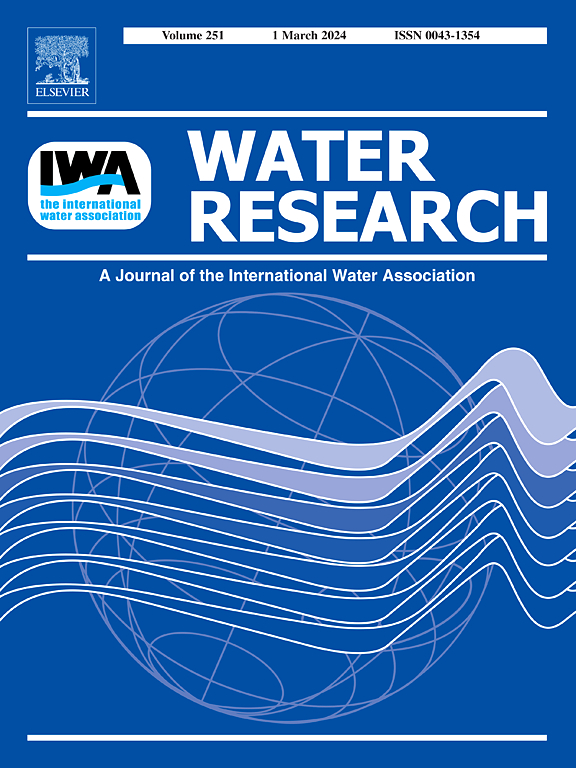Mechanism of electro-acclimation shaped microbiota facilitating phosphorus release from iron-containing sludge: microbial reduction and induced dissolution
IF 11.4
1区 环境科学与生态学
Q1 ENGINEERING, ENVIRONMENTAL
引用次数: 0
Abstract
Iron-based Chemically Enhanced Primary Treatment (Fe-CEPT) can efficiently concentrate phosphorus (P) from municipal wastewater into sludge; however, unfavorable P release efficiency impedes P recovery from Iron-based Chemically Enhanced Primary Sludge (Fe-CEPS). This study developed an electro-digester by applying controlled potentials to bio-electrodes. The electro-acclimated microorganisms on bio-electrodes achieved efficient P release due to microbial Fe(III) reduction and microbial metabolism-induced P-Fe complexes dissolution. In P release potential tests, 53.2 % of total P was released within 60 h after +1.0 V acclimation, 2.2-fold of the control. P fractionation analysis revealed that the proportion of Fe(II)-P, Fe(III)-P, and Reductant-P in Fe-CEPS (substrate) decreased by 9.7 %, 44.8 %, and 37.5 % after P release, respectively, combined with X-ray diffraction analysis, indicating P-release process followed Fe(III)-P and reductant-P first being reduced to Fe(II)-P and then dissolved into P(liquid), while inherent Fe(II)-P directly dissolved into P(liquid). The enhanced electron transfer capacity of electro-acclimated microorganisms, demonstrated by cyclic voltammetry analysis, promoted Fe(III)-P reduction. The lower pH (a minimum of 5.7) in mixed liquor, achieved by the enhanced metabolism of electro-acclimated microorganisms and elevated enzyme activities relating to hydrolysis-acidification, facilitated the dissolution of Fe(II)-P into the liquid phase. These two steps were dominated by enriched iron-reducing bacteria as Deferribacteraceae and fermentative bacteria as Clostridiaceae in electro-acclimation shaped microbiota. Metagenomic analysis showed consistent results as genes encoding cellular respiratory, metabolism and electron transportation upregulated significantly. These findings provided an eco-friendly, cost-effective solution for treating iron-containing chemical sludge and recovering valuable P resources.
电驯化型微生物群促进含铁污泥释磷的机理:微生物还原和诱导溶解
铁基化学强化一级处理(Fe-CEPT)可以有效地将城市污水中的磷(P)浓缩到污泥中;然而,不利的磷释放效率阻碍了从铁基化学强化初级污泥(Fe-CEPS)中回收磷。本研究通过在生物电极上施加可控电位,开发了一种电消化器。生物电极上的电驯化微生物由于微生物Fe(III)还原和微生物代谢诱导的P-Fe络合物溶解而实现了高效的P释放。在磷释放电位测试中,+1.0 V驯化后60 h内释放总磷的53.2%,是对照的2.2倍。P分选分析表明,在P释放后,Fe- ceps(底物)中Fe(II)-P、Fe(III)-P和还原剂-P的比例分别下降了9.7%、44.8%和37.5%,结合x射线衍射分析表明,P的释放过程是Fe(III)-P和还原剂-P先被还原成Fe(II)-P再溶解到P(液)中,而固有的Fe(II)-P直接溶解到P(液)中。循环伏安分析表明,电驯化微生物的电子传递能力增强,促进了Fe(III)-P的还原。混合液中较低的pH值(最低为5.7),是由于电驯化微生物的代谢增强和与水解酸化有关的酶的升高,促进了Fe(II)-P在液相中的溶解。这两个步骤以铁还原菌(铁杆菌科)和发酵菌(梭菌科)为主。宏基因组分析结果一致,编码细胞呼吸、代谢和电子传递的基因显著上调。这些发现为处理含铁化学污泥和回收有价值的磷资源提供了一种环保、经济的解决方案。
本文章由计算机程序翻译,如有差异,请以英文原文为准。
求助全文
约1分钟内获得全文
求助全文
来源期刊

Water Research
环境科学-工程:环境
CiteScore
20.80
自引率
9.40%
发文量
1307
审稿时长
38 days
期刊介绍:
Water Research, along with its open access companion journal Water Research X, serves as a platform for publishing original research papers covering various aspects of the science and technology related to the anthropogenic water cycle, water quality, and its management worldwide. The audience targeted by the journal comprises biologists, chemical engineers, chemists, civil engineers, environmental engineers, limnologists, and microbiologists. The scope of the journal include:
•Treatment processes for water and wastewaters (municipal, agricultural, industrial, and on-site treatment), including resource recovery and residuals management;
•Urban hydrology including sewer systems, stormwater management, and green infrastructure;
•Drinking water treatment and distribution;
•Potable and non-potable water reuse;
•Sanitation, public health, and risk assessment;
•Anaerobic digestion, solid and hazardous waste management, including source characterization and the effects and control of leachates and gaseous emissions;
•Contaminants (chemical, microbial, anthropogenic particles such as nanoparticles or microplastics) and related water quality sensing, monitoring, fate, and assessment;
•Anthropogenic impacts on inland, tidal, coastal and urban waters, focusing on surface and ground waters, and point and non-point sources of pollution;
•Environmental restoration, linked to surface water, groundwater and groundwater remediation;
•Analysis of the interfaces between sediments and water, and between water and atmosphere, focusing specifically on anthropogenic impacts;
•Mathematical modelling, systems analysis, machine learning, and beneficial use of big data related to the anthropogenic water cycle;
•Socio-economic, policy, and regulations studies.
 求助内容:
求助内容: 应助结果提醒方式:
应助结果提醒方式:


